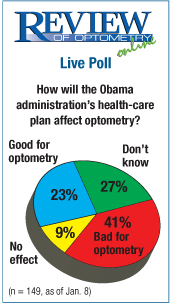During his election campaign, President-elect Barack Obama said that fixing the nation's broken health-care system will be one of his very highest priorities, and he promised to get started as soon as he took office.
"The time has come this year, in this new administration, to modernize our health-care system for the 21st century, to reduce costs for families and businesses, and to finally provide affordable, accessible health care for every single American," Mr. Obama said.
 Sound good? Many optometrists don't seem to think so. More than 40% of O.D.s who responded to the Review of Optometry Online Live Poll think the Obama administration's health-care plan will be bad for optometry.
Sound good? Many optometrists don't seem to think so. More than 40% of O.D.s who responded to the Review of Optometry Online Live Poll think the Obama administration's health-care plan will be bad for optometry.
"I think we all agree that there are various aspects of our medical care delivery system that really need major overhauling or need to be addressed," says optometrist and U.S. Representative John Boozman (R-Ark.).
"The Obama administration hasn't unveiled its health reform plan yet, so no details are available. We know this is a big priority for him, but we don't know any of the specifics of the plan hes about to come out with," Rep. Boozman says.
Nevertheless, Mr. Obama has made it clear his administration will try to tackle a few key issues:
Affordable, accessible health care for every American. More than 45 million Americans lack health insurance, and another 25 million are underinsured, Mr. Obama has stated. Meanwhile, health insurance premiums have doubled in the past eight years.
To address this, the Obama plan would foster accessible health coverage by creating a National Health Insurance Exchange—a marketplace of insurance plans in which all insurers are required to participate. This would give uninsured Americans options for competitively priced health plans. Also, individuals who do have health insurance could choose one of these plans rather than opting for insurance through their employer. All plans would be portable.
"This is not a single-payer system or even mandatory universal coverage—although it would encourage all Americans to obtain health insurance," says Barry J. Barresi, O.D., Ph.D., a health policy expert as well as executive director of the American Optometric Association.
Dr. Barresi points to a call to action introduced in November by Sen. Max Baucus (D-Mont.), chairman of the Senate Finance Committee. The Baucus report, offered as a blueprint for the Obama transition team, proposed the National Health Insurance Exchange as a way to cover the uninsured and to supplement
Along those lines, the Obama administration would require medium-sized and large-sized employers to provide meaningful coverage. Small employers, such as most optometry practices, would be exempt or receive a tax credit to help offset providing coverage.
In addition, Mr. Obama has called for mandatory coverage for all children. He plans to expand Medicaid and the State Children's Health Insurance Program (SCHIP) to cover children who arent insured by their parents plan.
Preventive care and chronic disease. Less than four cents of every health-care dollar is spent on prevention and public health, according to Mr. Obama's tentative health-care reform plan. "Our health-care system has become a disease care system, and the time for change is well overdue," it says.
One in three Americans—133 million—has a chronic condition, according to the Obama plan, citing statistics from
The Obama plan would encourage worksite and school disease prevention programs, including health screenings, vaccinations, healthy nutrition standards and exercise programs. It would encourage employers to choose health coverage that includes prevention programs, support school-based health screening programs and clinical services, and increase financial support for physical education and health educational programs for students.
 Who Will Run It?
Who Will Run It?
A pivotal question hangs in the air—a remainder from the crusade for single-payer health care reform from the
One indication: In December, Mr. Obama appointed former Senate majority leader Tom Daschle to serve as secretary of Health and Human Services as well as director of a new White House Office of Health Reform. "As such, he will be responsible not just for implementing our health care plan, he will also be the lead architect of that plan," Mr. Obama said.
Mr. Daschle has suggested creating a new Federal Health Board, which would be an independent agency much like the Federal Reserve Board. "Just as the Federal Reserve ensures certain standards for our banking industry, the Fed Health would ensure harmonization across public programs of health-care protocols, benefits and transparency," Mr. Daschle has said. Additionally, the Fed Health could set standards for quality and coverage, promoting best practices and identifying the trade-offs on services.
Mr. Daschle says the Federal Health Board would create savings by reducing administrative costs. But, many opponents don't see it that way.
"When you look at the track record of government being involved in health care, it's not very good," says Rep. Boozman. "The most efficient way, and in the long run the least expensive way, is the private system."
Again, no details are yet available. Whether Mr. Daschle will actually try to establish such a board remains to be seen. In the meantime, Mr. Daschle is already reaching out to the public by initiating online discussions to gather grassroots input on health care reform.
What Will it Cost?
The jackpot questions: How much will it cost, and where will the money come from?
If fully implemented, the Obama plan will cost an estimated $75 billion in 2009, and grow to roughly $130 billion per year by 2018, according to a report by PricewaterhouseCoopers' Health Research Institute.
But, can the Obama administration reform health care while simultaneously pulling the nation out of the worst economic slump in years?
"It is becoming more and more apparent, particularly during the current economic downturn, that health care is also very much an economic issue," says Edwin C. Marshall, O.D., M.S., M.P.H., a public health and health policy expert as well as vice president for Diversity, Equity and Multicultural Affairs at Indiana University.
In his campaign speeches, Mr. Obama pointed to the highand risingcost of providing health care. He said that reforming health care has to be intimately woven into the entire economic recovery plan. "It's not something that we can sort of put off because were in an emergency. This is part of the emergency," he said.
The Obama health plan aims to reap savings in a number of important ways:
• Institute an entirely electronic health records system.
• Increase participation in disease management programs.
• Improve coordination of care.
• Institute a center for the dissemination of evidence-based research.
• Reform medical malpractice.
• Increase competition in the insurance industry and the pharmaceutical industry.
• Offset the high costs of catastrophic illnesses.
Mr. Obama has said that these improvements, and others, will save up to $2,500 in medical costs for the typical American family.
Optometry at the Table
The Obama administrations focus on prevention, chronic care programs and cost containment may bode well for optometrists. "We know that optometry can provide high quality eye-care services with greater access to full-scope, coordinated care," Dr. Barresi says.
Now, optometry needs to inform the new administration about this. "Optometry needs to be at the table and be part of the decisions as to how we move forward," Rep. Boozman says.
To that end, the Patients Access to Responsible Care Alliance (PARCA) sent a letter to President-elect Obama to emphasize the role of non-M.D./D.O. health-care providers. PARCA is comprised of 11 health-care organizations, including the American Optometric Association. The letter asks Mr. Obama to establish a level playing field that eliminates discrimination against non-M.D./D.O. providers to increase patient choice and access, streamline the delivery of care and improve quality outcomes.
"The AOA also is working hard to have the ear of many health policy makers, particularly through its new
Meanwhile, the National Commission on Vision and Health, a non-partisan group of health leaders, "has placed particular emphasis on ensuring that optometry is recognized at the federal level as a primary care profession," says Dr. Marshall, who is chair of the commission. "It will work with the nations policy makers, health administrators and public health agents to improve access to vision care by assuring that vision care is a fully integrated component of public health."
The Obama administration's promise of change implies, among other things, meaningful and positive change in health care, Dr. Marshall says. "Eye and vision care is well positioned to be impacted by such change."

